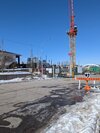DougB
Active Member
I would think that CP would be motivated to reduce its liability risk around a major derailment, and improve operational performance through bypassing the Calgary bottleneck.I agree, being near the tracks isn't much of an issue from a nuisance perspective and can easily be mitigated and typically you'd get used to it.
This comment doesn't apply to this development alone, but that recent train crash chemical spill in the US got me thinking about it again - in the long-term, is there any legitimate strategy is to reduce the risk of derailment in the city centre?
As far as I know, Calgary's the largest city in Canada with a heavy freight rail main line straight through the centre, next largest is probably Winnipeg? Both Montreal and Vancouver have port facilities and access lines nearby, but I don't think they often see much speed or volatile loads coming directly through the urban core - most of the most dangerous stuff goes to specific terminals spread elsewhere in their region.
We have discussed on this forum previously about geographical constraints to moving the CP corridor itself - there really isn't any good options for moving heavy trains into and out of the Bow Valley other than the existing right-of-way. Would be a wild, multi-billion kind of megaproject that doesn't seem particularly realistic anytime soon.
But time goes on. If growth continues, Calgary will be 2 million people, maybe 3 million one day. A few hundred thousand people might eventual live right in the core very close to the corridor. The CP corridor isn't likely to get less busy anytime soon either. That's a lot of growing risk in the event of a derailment, even if it's not very likely. Seems like a black swan type of risk event - the risk never seems high enough to do anything about it compared to the cost, however if something rare did happen the results could be very dangerous and extremely costly.
Would be curious to hear from people who have more insight into this than me. I really don't know how risky it is, nor what types of chemicals and train loads are present in the Bow Valley CP corridor, nor how we should/could really even think or approach mitigating this risk.
That being said, I can't think of an obvious location to exit the Bow Valley west of Calgary. Further west would require switchbacks or a tunnel to get through Scott Lake Hill. Closer to the city would require bank cuts, tunnels and bridges to rise out of the valley. Once out of the valley, bypassing north would add additional trackage vs. bypassing south. Land acquisition and terrain would be easier to the north.
A future dam west of Calgary will require some rail line relocation. Maybe that would be an opportunity to move the line out of the valley. I would expect all options to cost into the billions. Calgary is where it is for a reason.
